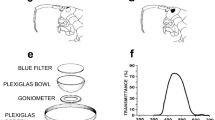Summary
In the compound eye of Notonecta glauca, the backswimmer, there is a small ventral region in which the rhabdoms differ in structure from those in the other parts of the eye. Here, among other unusual features, there is a special orientation of the microvilli of the central rhabdomeres, i.e., in most of the median eye region that has been examined, the microvilli of the two central rhabdomeres are aligned with one another, at an acute angle to the transverse axis of the body. In the small ventral region, the microvilli of these rhabdomeres are perpendicular to one another, those of one rhabdomere being almost exactly in parallel with the median plane of the animal, and those of the other, almost exactly at right angles to the median plane.
When Notonecta is hanging under the water surface, the field of vision of the ventral part of the eye coincides with the transparent part of the water surface. Within the ventral eye region there is a bandlike zone only four ommatidia wide; the ommatidia here differ from the others in the ventral eye region by the unique orientation of their central rhabdomeres. With this zone the animal views the area ahead of it just above the water surface. When the backswimmer is flying, the ventral part of the eye views a region that begins under the animal and extends forward from the vertical over ca. 35 °. Possible relationships between the special orientation of the microvilli in the ventral eye region and the polarization of the light by the water surface are discussed.
Similar content being viewed by others
References
Batschelet E (1965) Statistical methods for the analysis of problems in animal orientation and certain biological rhythms. Am Inst Biol Sc Washington
Bedau K (1911) Das Facettenauge der Wasserwanzen. Z wiss Zool 97:417–456
Goldsmith TH, Wehner R (1977) Restrictions of rotational and translational diffusion of pigment in the membranes of a rhabdomeric photoreceptor. J Gen Physiol 70:453–490
Grenacher H (1879) Untersuchungen über das Sehorgan der Arthropoden. Vandenhoeck und Ruprecht Göttingen
Herrling PL (1976) Regional distribution of three ultrastructural retinula types in the retina of Cataglyphis bicolor (Formicidae, Hymenoptera). Cell Tissue Res 169:247–266
Horridge GA (1968) A note on the number of retinula cells of Notonecta. Z vergl Physiol 61:259–262
Labhart T (1980) Specialized photoreceptors at the dorsal rim of the honeybee's compound eye: Polarization and angular sensitivity. J Comp Physiol 141:19–30
Langer H (1965) Nachweis dichroitischer Absorption des Sehfarbstoffes in den Rhabdomeren des Insektenauges. Z vergl Physiol 51:258–263
Lüdtke H (1953) Retinomotorik und Adaptationsvorgänge im Auge des Rückenschwimmers (Notonecta glauca L.). Z vergl Physiol 35:129–152
Lüdtke H (1957) Beziehungen des Feinbaus im Rückenschwimmerauge zu seiner Fähigkeit polarisiertes Licht zu analysieren. Z vergl Physiol 40:329–344
Räber FW (1979) Retinatopographie und Sehfeldtopologie des Komplexauges von Cataglyphis bicolor (Formicidae, Hymenoptera) und einiger verwandter Formiciden-Arten. Inaugural-dissertation der philosophischen Fakultät II der Universität Zürich
Schinz RH (1975) Structural specialization in the dorsal retina of the bee Apis mellifera. Cell Tissue Res 162:23–34
Schneider L, Langer H (1969) Die Struktur des Rhabdoms im „Doppelauge” des Wasserläufers Gerris lacustris. Z Zellforsch 99:538–559
Schwind R (1980) Geometrical optics of the notonecta eye: Adaptations to optical environment and way of life. J Comp Physiol 140:59–68
Schwind R (1983) A Polarization-sensitive response of the flying water bug Notonecta glauca to UV Light. J Comp Physiol 150:87–91
Snyder AW (1973) Polarization sensitivity of individual retinula cells. J Comp Physiol 83:331–360
Trujillo-Cenóz O, Bernard GD (1972) Some aspects of the retinal organization of Sympycnus lineatus Loew (Diptera, Dolichopodidae). J Ultrastruct Res 38:149–160
Wallon GA (1935) Field experiments on the flight of Notonecta maculata Fabr. (Hemipt.). Transact Soc Brit Ent Vol. II Part 3:137–144
Waterman TH (1981) Polarization sensitivity. In: Autrum H (Ed) Handbook of sensory physiology. Vol. VII/6B: Vision in invertebrates. Springer Berlin Heidelberg New York, p 281
Wehner R, Räber F (1979) Visual spatial memory in desert ants, Cataglyphis bicolor (Hymenoptera: Formicidae). Experientia 35:1569–1571
Author information
Authors and Affiliations
Rights and permissions
About this article
Cite this article
Schwind, R. Zonation of the optical environment and zonation in the rhabdom structure within the eye of the backswimmer, Notonecta glauca . Cell Tissue Res. 232, 53–63 (1983). https://doi.org/10.1007/BF00222373
Accepted:
Issue Date:
DOI: https://doi.org/10.1007/BF00222373




